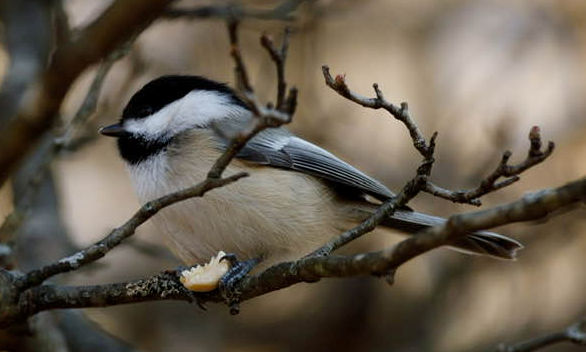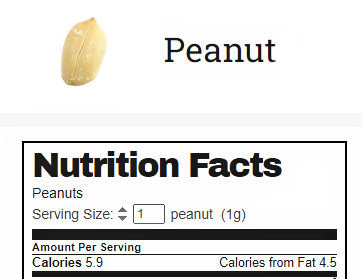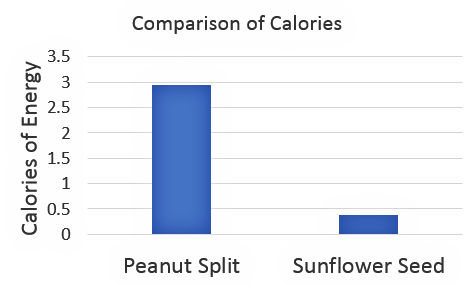Dr. Ray L. Winstead
Professor of Biology (retired),
Indiana University of
Pennsylvania
Bird
Seed Preference

Photo by Cheri Widzowski showing the little "beak
bites" that the chickadee takes while holding the "peanut split" with its feet.
When I go to Blue Spruce Park to feed the
birds out of my hand, I take a combination of Black Oil Sunflower Seeds and
"Peanut Splits." My observations indicate that White-breasted
Nuthatches, Tufted Titmice, and most Black-capped Chickadees prefer to eat a "peanut
split" from my hand, rather than choosing a Black Oil Sunflower Seed. A
"peanut split" is half of a peanut, where the peanut has been taken out of its shell/hull and split into
the two halves, each half storing a lot of energy - as indicated below. All
three bird species do
also eat the sunflower seeds out of my hand.
Margaret Higbee is the one who
first told me about offering the peanut splits, in addition to the sunflower
seeds. (Basically, the birds that come to your hand will just ignore smaller
seeds, and I don't even offer them.)
The great photo above, taken by Cheri Widzowski, shows the little "beak bites" that the chickadee takes while holding the
"peanut split" with its feet. My observations indicate that a chickadee will do
this nearby with the first peanut taken from my hand, and then the chickadee
takes the subsequent peanuts to cache farther away (as well as taking most of
the first one away after some initial "beak bites.")
So, why do these birds choose a peanut split
to eat out of my hand, rather than a sunflower seed?
Of course, I don't know what is in a
chickadee's mind, BUT peanuts are known to provide a high-energy food for these
birds!
For example, consider the chickadee.
It is
estimated that chickadees need about 10 kcal of energy per day to survive (Link
to Reference).
(Note that 1 kilocalorie is exactly the same
as 1 Calorie - with a capital C - as used on human food labels.
1. For comparison, "Generally, the
recommended daily Calorie intake is 2,000 Calories a day for women and 2,500 for
men."
Link to Reference.
2. For comparison, an elephant eats 70,000
Calories each day.
Link to Reference)
One peanut provides, on average, 5.9 Calories
of energy.

Click the image or here for Reference)
So, each
peanut split I offer would have about 2.95 Calories. (Some of the peanut
splits are broken into smaller pieces, and nuthatches will immediately swallow
one of those before picking up and flying off with a larger peanut split.)
So, the peanut split the chickadee takes to eat or cache is 29.5% of its average
daily requirement of energy.
In
comparison, a sunflower seed has about 0.3875 Calories of energy, i.e. 3.875% of
a chickadee's average daily requirement.
(Package of sunflower seeds in their shells:
1.3333 cups has 310 Calories. A 0.25 cup has 150 seeds.
So, each sunflower seed has 0.3875
Calories of energy.
Link to Reference)

So, many of these birds may be choosing peanut
splits over sunflower seeds because of the higher energy content.
Whether or not
the birds actually know this is a separate question.
(Maybe they just like the texture of the peanut
splits better(?).)
(Perhaps they are just
picking the larger seeds. However, other studies show that chickadees prefer the
smaller Black Oil Sunflower seeds over the larger Striped Sunflower seeds.
Striped Sunflower seeds are known to have thicker seed coats. I do observe
birds choosing the larger peanut splits first out of my hand over the smaller
peanut splits.)
Addendum note (3.23.2024):
The male Downy Woodpecker "White Feather" (One white feather in
his black cap) came to my hand three times today and picked up a peanut split
(half a peanut) each time while my hand was touching a tree trunk - just as he
did three times a couple of days ago. (He came close yesterday - but I think the
other people with me dissuaded him from coming over.) Just as I have witnessed
the female Downys do in previous years, White Feather each time flew to a nearby
large branch, banged the peanut into a crevice, and then ate the peanut right
there in front of me - with little bites. Just as two days ago, he did not come
back today after doing that three times. I think he was full! I checked online
and found that caching food by Downy Woodpeckers is basically absent! I had
previously checked on calorie input for chickadees and found that a chickadee
eats about 10 Calories a day - and chickadees do cache food. Again, note the
great photo above taken by Cheri
Hinchman Widzowski that
"shows the little 'beak bites' that the chickadee takes while holding the
'peanut split' with its feet. My observations indicate that a chickadee will do
this nearby with the first peanut taken from my hand, and then the chickadee
comes back and takes the subsequent peanuts to cache farther away (as well as
taking most of the first one away after some initial 'beak bites.'" Downy
Woodpeckers weigh about 25 grams, while chickadees weigh about 12 grams. So, my
guess (but I could not verify online) is that Downy Woodpeckers need about 20
Calories per day. Each peanut split has about 3 Calories, so White Feather ate
about 9 Calories in front of me and then stopped.
Special Request: DO NOT JUST
PUT BIRD SEED ON THE GROUND, BENCHES, OR STUMPS! This will "untrain" the birds
to come to our hands (and also possibly make these wild birds too dependent on
humans). Do leave the few seeds that the birds knock out of your hand
onto the ground, since other birds, such as Cardinals, Red-bellied Woodpeckers,
and Blue Jays will come down and get those right after you leave. In fact, when
you leave and walk away, then look back to confirm that these birds have been
watching and waiting for their turn. (You can decide for yourself if these birds
are "too afraid" to come to your hand or too smart to take the risk - even
though you can see them watching the other birds doing it safely and being
successful.)
Previous
Chickadees Home
Next


Christian
Essentials
Dr. Winstead's Blood
Pressure Tracker: Free Templates for Graphing Blood Pressure in Microsoft
Excel
Dr. Winstead's Current Local and World Standard
Percentage Metric Time Clock
Blue Spruce Park Chickadees
Dr. Ray L.
Winstead
rw ( at ) raywinstead ( dot ) com
bs


